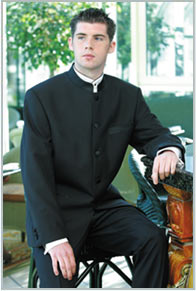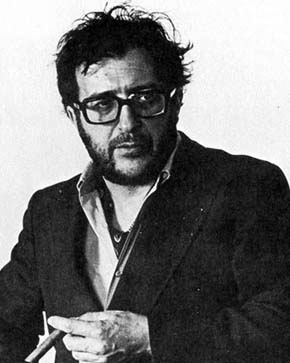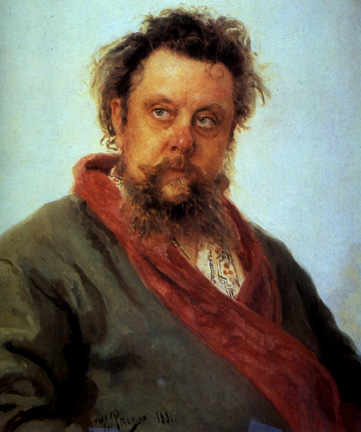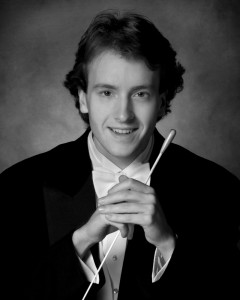On the subject of male dress for classical concerts
There are, essentially, four options. Â From the most formal to the least:
(1) White Tie: a dress coat (i.e. tails); a well-starched white shirt (piqué); cummerbund, suspenders or (preferably) a white piqué vest; black patent leather shoes; and of course, a white piqué bow tie.
(2) Black Tie: black tuxedo, white tuxedo shirt (ruffled or non-), cummerbund or suspenders, black patent leather shoes, black bow tie.
(3) Suits: dark suit (black, grey or, in a real pinch, navy blue… my condolences to the owners of navy blue suits everywhere), white shirt, tie of choice (see below), black shoes.
(4) All Black: the most formal variation being a tuxedo with a black turtleneck underneath.
But definitions will get us only so far. Â The question is on which occasions should each of these costumes be worn? Â It is with regards to this question that I frequently encounter such pitiable ignorance — or even sheer lack of concern (!)
White Tie is worn by professional orchestras at regular subscription concerts. Â It is also worn by guys intent on “tickling pink” their particular dame on a given Saturday night. Â In either situation, the gleam from the gentlemen’s torsos casts an intoxicating, radiant shimmer on the proceedings.
Black Tie is worn by community and student orchestras for their regular concerts. Â It is also worn by professional orchestras during the summer season, with one particular alteration: white dinner jackets rather than black.
Suits are to be worn at any concert taking place before the evening, or at any evening concert where a slightly less formal atmosphere is desired. Â While suits are not nearly as formal as White Tie, they are not such a drop down from Black Tie to render them inappropriate for formal concerts. Â They may also be worn by certain (often European) orchestras during their summer seasons.
All Black dress is reserved for two particular situations: new music concerts (where the dress code is interpreted as “dark” and “edgy”) and playing in pit orchestras (more often for musicals than opera). Â All black should never be worn during a daytime concert of standard repertoire music; suits are the appropriate garb for such occasions. Â The amount of difficulty I have encountered in trying to convince student musicians of this most self-evident of rules defies explanation.
Then comes the all-important question: what does the conductor wear? Â I believe I can answer this with one simple word: concordance. Â The conductor should simply wear whatever the gentleman of the orchestra are wearing. Â This rule applies equally as well to lady conductors as to their gentleman counterparts.
 Now that the basics have been established, one may consider certain variations and exceptions. Â Many conductors use variations in their wardrobe to present an individualized podium presence. Â The so-called “Nehru” jacket is a form of attire worn by a great many conductors to show how individual they are. Â This can be appropriately worn with an orchestra wearing either White or Black Tie, but not suits.
Now that the basics have been established, one may consider certain variations and exceptions. Â Many conductors use variations in their wardrobe to present an individualized podium presence. Â The so-called “Nehru” jacket is a form of attire worn by a great many conductors to show how individual they are. Â This can be appropriately worn with an orchestra wearing either White or Black Tie, but not suits.
There is then what I like to call the “Leonard Slatkin”:
 This is a dress frequently worn by Mr. Slatkin and historically associated with various mafioso types. Â A sort of “inverted Black Tie”, this outfit defies easy categorization. Â It has a solemn, yet bold overall appearance, and combines the class of a tuxedo with the “attitude” of all black.
This is a dress frequently worn by Mr. Slatkin and historically associated with various mafioso types. Â A sort of “inverted Black Tie”, this outfit defies easy categorization. Â It has a solemn, yet bold overall appearance, and combines the class of a tuxedo with the “attitude” of all black.
I myself have worn this dress on occasion: mainly in pits and at Good Friday services. Â
Kudos to Mr. Slatkin for picking up on my trend-setting idea.
The conductor may also opt for various bow tie replacements: simple studs that match one’s cuff links are a popular option, as are a number of alternate collar types that require no tie at all.
A few additional notes: White Tie offers no real chances for individual variation; the basic elements of costume itself offer all the magnificence that a normal imagination could ever desire. Â Black Tie offers one chance to stand out: the cuff links. Â A suit, on the other hand, has the singular advantage of allowing its wearer considerable room to express himself in the choice of tie. Â One important consideration is that, if at all possible, the tie should match the specific character of the music. Â I, for example, have worn purple to conduct Dvorak, a somber blue for the Elgar Cello Concerto, and pink for Beethoven’s 1st.
The chance to wear formal attire, specifically tails, was perhaps the principal motivation behind my choice to become a conductor. Â Were I to limit my musical activities to composing, dressing up would hardly an option. Â Most composers look like total schlubs, including me when I am just sitting around the house writing music. Â Case in point:
Mr. Berio, ready for his next Scorsese cameo

Mr. Ligeti, in one of his two (2) outfits (although in his latter years, this may have been reduced to one (1))

Kramer, the minimalist

And of course, the great nineteenth century Russian composer, ZZ Top



 Now that the basics have been established, one may consider certain variations and exceptions. Â Many conductors use variations in their wardrobe to present an individualized podium presence. Â The so-called “Nehru” jacket is a form of attire worn by a great many conductors to show how individual they are. Â This can be appropriately worn with an orchestra wearing either White or Black Tie, but not suits.
Now that the basics have been established, one may consider certain variations and exceptions. Â Many conductors use variations in their wardrobe to present an individualized podium presence. Â The so-called “Nehru” jacket is a form of attire worn by a great many conductors to show how individual they are. Â This can be appropriately worn with an orchestra wearing either White or Black Tie, but not suits. This is a dress frequently worn by Mr. Slatkin and historically associated with various mafioso types. Â A sort of “inverted Black Tie”, this outfit defies easy categorization. Â It has a solemn, yet bold overall appearance, and combines the class of a tuxedo with the “attitude” of all black.
This is a dress frequently worn by Mr. Slatkin and historically associated with various mafioso types. Â A sort of “inverted Black Tie”, this outfit defies easy categorization. Â It has a solemn, yet bold overall appearance, and combines the class of a tuxedo with the “attitude” of all black.


